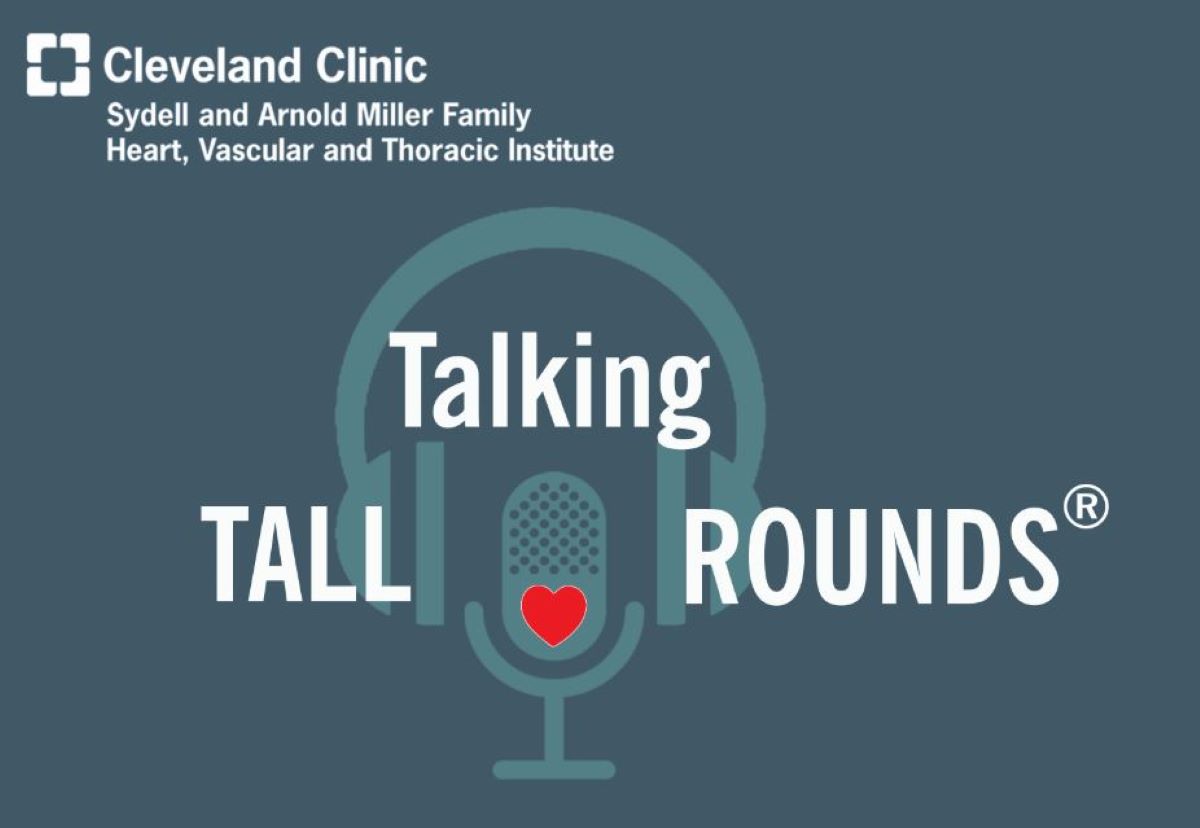Talking Tall Rounds®: TAVR vs SAVR - Small Annulus Considerations

Amar Krishnaswamy, MD, provides the TAVR perspective on SAVR in patients with small annulus, including outcomes of TAVR vs SAVR.
Learn more about Tall Rounds online.
Subscribe: Apple Podcasts | Podcast Addict | Buzzsprout | Spotify
Talking Tall Rounds®: TAVR vs SAVR - Small Annulus Considerations
Podcast Transcript
Announcer:
Welcome to the Talking Tall Rounds series, brought to you by the Sydell and Arnold Miller Family Heart, Vascular and Thoracic Institute at Cleveland Clinic.
Amar Krishnaswamy, MD:
Some points to ponder just in the next few minutes. One, what are the outcomes of TAVR and SAVR in patients with a small annulus generally speaking. Is there a preferred TAVR platform for patients with a small annulus? And also a little bit of perspective from the TAVR side on surgical AVR in patients with a small annulus. This is a study published recently, relatively small, a low surgical risk group of patients, 151, who were suitable for either surgical or transcatheter AVR. They were randomized 50-50 to one or the other. Ultimately, there was no real difference in valve gradients in the early term or sixty-day echocardiographic outcome. What you also see is that a median follow-up of about two years, no significant difference in these clinical outcomes. Again, a small study, a number of caveats. These patients were thought amenable to both treatment options, but perhaps encouraging data to say ultimately as a group when we decide what is the better treatment for a given patient's surgery or TAVR, we're likely to come up with a good solution in either capacity.
Now, there's been a lot of interest recently in this idea of self-expandable versus balloon-expandable valves in the small annulus population. This is sort of the take-home graph from the SMART study that was published recently. This was an industry-funded study by Medtronic comparing their self-expandable supra-annular transcatheter valve platform to the balloon-expandable Edwards SAPIEN platform. There were two co-primary endpoints. The second co-primary endpoint that is most talked about is this bioprosthetic valve dysfunction at 12 months that was substantially higher in the balloon-expandable platform compared to self-expandable. This is primarily an outcome that was the result of elevated gradients with the balloon-expandable valve, mean gradients over 20 millimeters. But what you see is that at 12 months there's absolutely no difference in clinical outcomes, including things like hospitalization for heart failure. So, one of the considerations is that at 12 months we're simply not going to see these kinds of differences in clinical outcomes.
But if you actually look back, this was a smaller trial, 240 patients randomized between self-expandable and balloon-expandable valves. At five years there was no difference in clinical outcomes actually between these two groups in major outcomes except perhaps a higher rate of new pacemaker for the self-expandable platform, which is a known complication. Similarly, there was a non-industry-funded study called the BERN TAVI study, and this group, again, out at five years, absolutely no difference in mortality for balloon versus self-expandable valves. In fact, the red curves are the self-expandable platform for what that's worth.
There's a number of reasons for this. Partly, Dr. Rodriguez has already discussed these issues of how we truly understand prosthetic valve function. And this is just a very small and somewhat thought-provoking paper that was published looking at 13 patients with a TAVR with a balloon expandable valve with a mean gradient over 20. Of those, just over two-thirds, in fact, when assessed invasively did not have a gradient over 20. So there's something here in the ECHO and how we understand flow dynamics and pressure recovery that perhaps we're not adequately assessing the hemodynamics of the valve. There's actually a larger study called DISCORDANCE, which will be presented at the TCT conference next year looking exactly at this... Sorry, next week, looking at this difference between ECHO and invasive gradients.
This is of course a controversial topic. We've written a number of editorials on exactly this and trying to be a little bit more critical of the literature and what we know about choosing valves, self-expandable versus balloon and expandable. The bottom line really is that there are a number of patient-specific and anatomic-specific factors that we consider. Specific to this patient down here we look at the sinuses of Valsalva and the feasibility of a future TAV-in-TAV, and I'll provide just a case illustration of the same. Again, we do know that there are lower echocardiographic gradients, and if that's the only consideration, maybe aesthetically that's something to think about.
When we look at our patients, we really need to understand the anatomy of the TAVR prosthetics, the height of the coronary leaflets, the height of the commissure, because when we're going to think about putting a TAVR inside of a TAVR in the future, the index TAVR leaflets are going to go up to the side and that's where you could or could not occlude the coronary vessels. So this is a patient who has a bit of a bigger annulus than the case presented. This would size for a 23 millimeter valve, not a 20 millimeter like the patient Brian presented. The sinuses are relatively large in size. You can see if you put a self-expandable valve, the commissures would get up to about 26 millimeters. We would not be able to put another TAV inside of that, but with a balloon expandable valve which is shorter, this clearly leaves the coronaries free for a future TAV-in-TAV.
This was a 74-year-old patient, and so we presume that at 10 years when this valve fails, she hopefully should still be alive. And so that's what we did. And you can see here that there is space there for the left main to fill even after we place another TAV. So the things to consider here with this as a background for a patient with a 20 millimeter valve, it's a small valve to put another TAVR into. We might not get a full expansion of that second valve, might get even worse hemodynamics than you're worried about at the index procedure. These are considerations to keep in mind. Certainly, if even a balloon expandable valve wouldn't allow freedom from coronary occlusion in the future, that would be a total non-starter for a future TAV-in-TAV, especially for a young patient like this.
So just to close out from a TAVR perspective, what are some surgical considerations? This was a patient with a small annulus who underwent an aortic root enlargement and surgical valve replacement. You can see here the sinuses at the coronary level measure almost 37 millimeters. This was a 25 millimeter surgical valve in which we can place a 26 millimeter TAVR valve. This is simulated, and you can see that even though the coronary is low with the root enlargement and how the surgical valve was placed, we're going to get coronary flow through here even after we push up the surgical leaflets. So this works out as a great root enlargement and surgical treatment for that patient.
This is another patient who had a small annulus, underwent a root enlargement. You can see here the root is certainly larger and you can appreciate that in the sagittal plane as well. However, just the way the surgical valve is implanted, it really favors toward the left sinus and the left main. If you look in the sagittal image here, this is a surgical valve frame, and when we put a TAVR in here, that's just going to simply go and occlude the left main. So just doing a root enlargement, putting in a large surgical valve does not necessarily imply the suitability of a future TAV-in-TAV. I think that's something that we have conversations a lot myself, Eric, Michael, Faisal, about approaching these cases.
To conclude, there's currently no clinical data supporting the superiority of one valve platform over another in patients with small annulus. The right choice for a patient is an important decision that considers root anatomy, feasibility of future options, patient risk and so forth, our thorough heart team assessment that we conduct weekly. In patients with life expectancy that is greater than what we appreciate for the valve longevity, appropriate planning for future TAV-in-TAV or TAV-in-SAV must be considered. So, thanks very much.
Announcer:
Thank you for listening. We hope you enjoyed the podcast. Like what you heard? Visit Tall Rounds online at clevelandclinic.org/tallrounds and subscribe for free access to more education on the go.

Cardiac Consult
A Cleveland Clinic podcast exploring heart, vascular and thoracic topics of interest to healthcare providers: medical and surgical treatments, diagnostic testing, medical conditions, and research, technology and practice issues.



